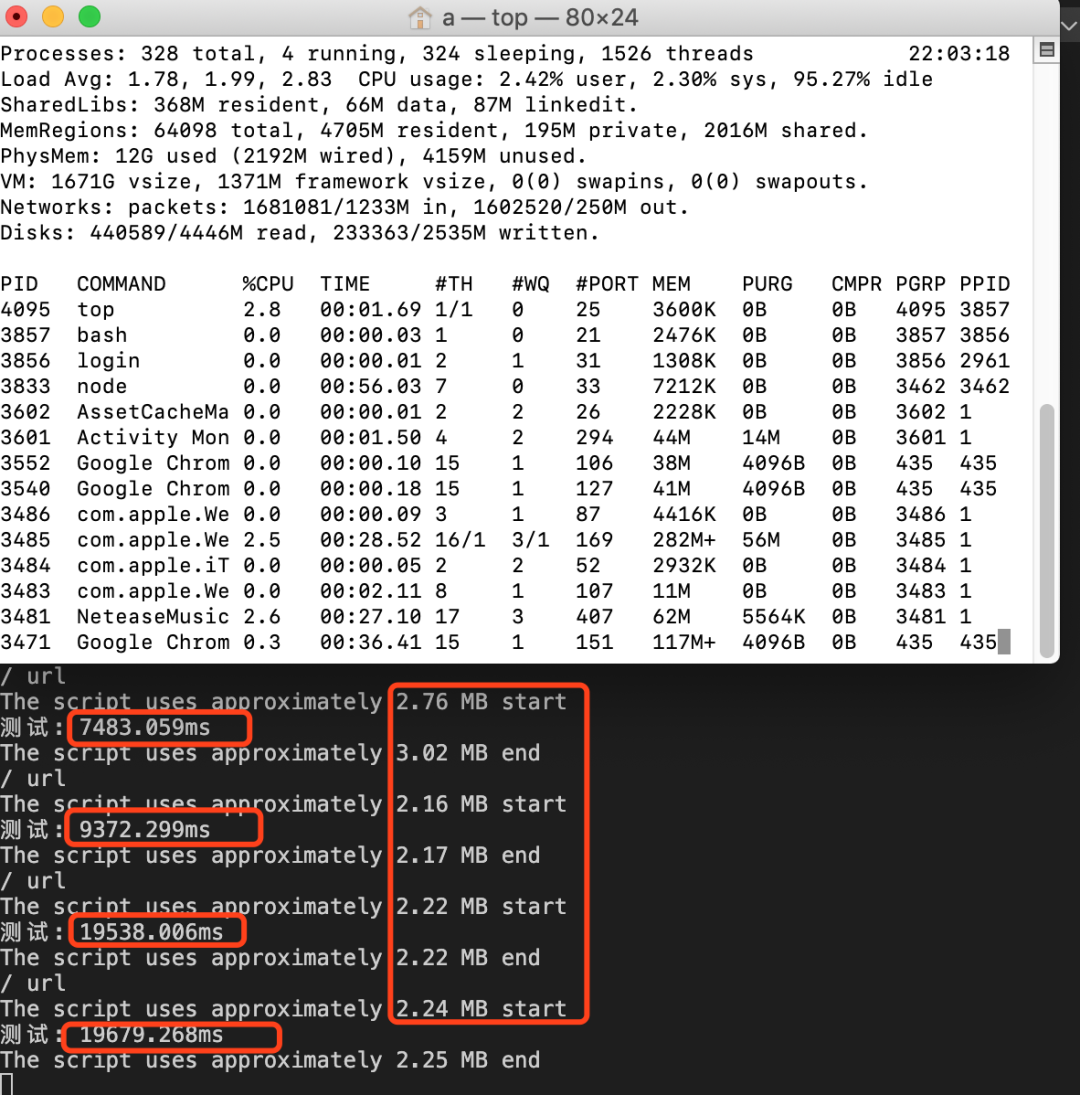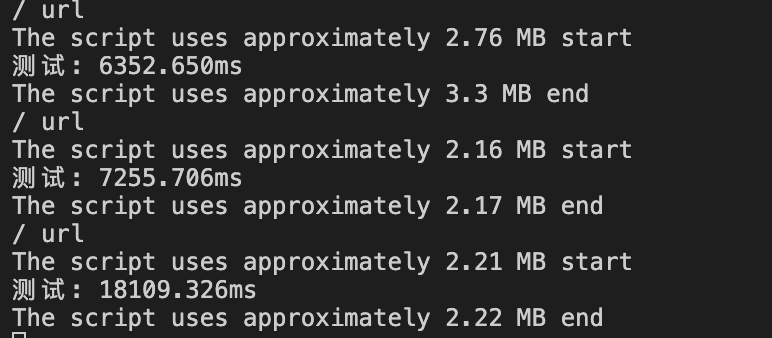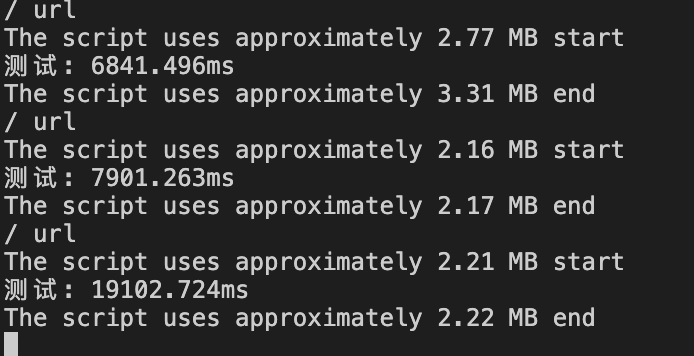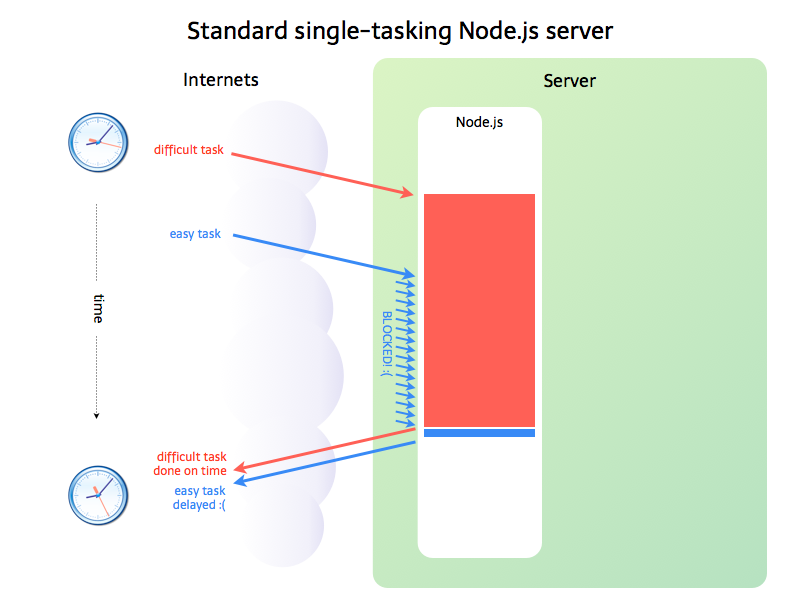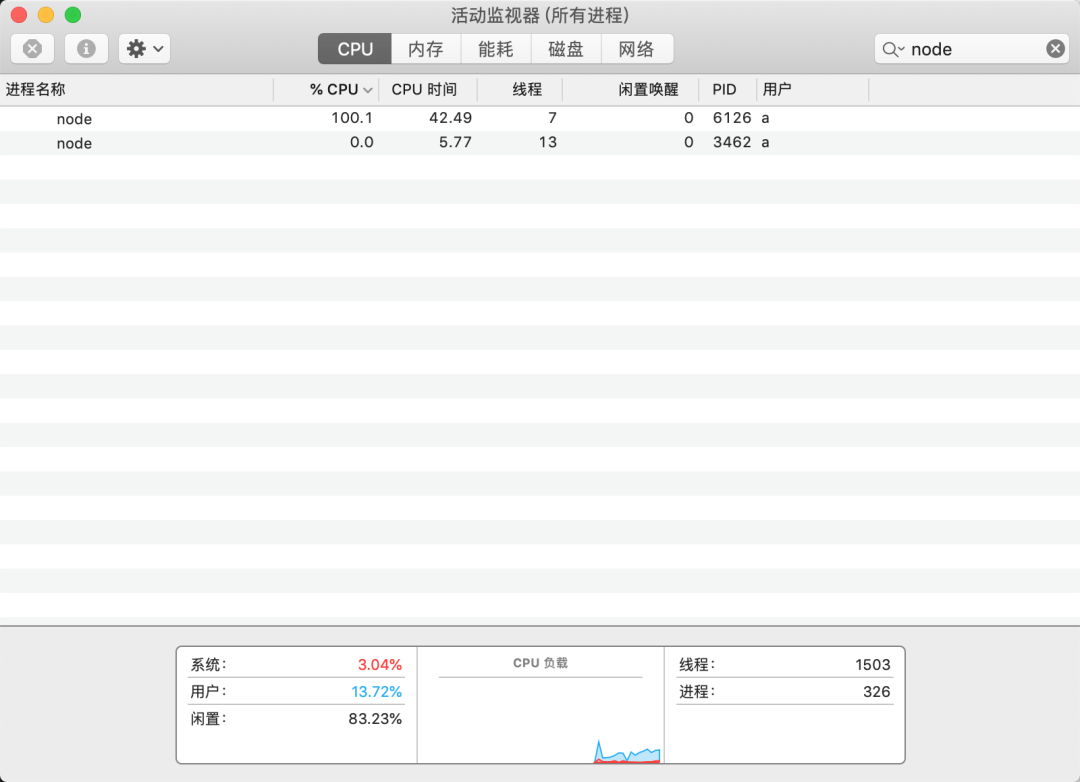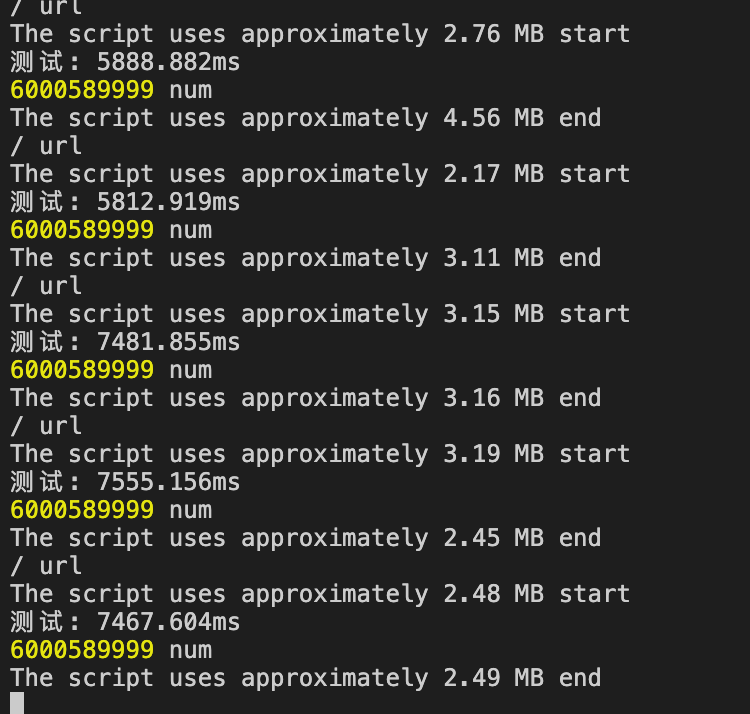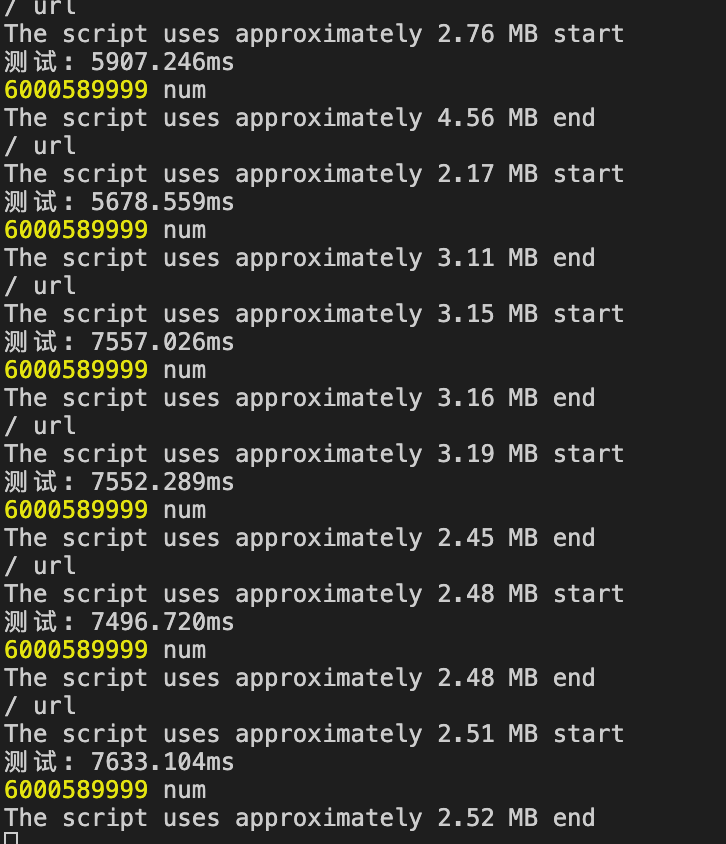60 亿次 for 循环,原来这么多东西
起因
-
有人在思否论坛上向我付费提问 -
当时觉得,这个人问的有问题吧。仔细一看,还是有点东西的
问题重现
-
编写一段 Node.js代码
var http = require('http');
http.createServer(function (request, response) {
var num = 0
for (var i = 1; i < 5900000000; i++) {
num += i
}
response.end('Hello' + num);
}).listen(8888);
-
使用 nodemon启动服务,用time curl调用这个接口

-
首次需要
7.xxs耗时 -
多次调用后,问题重现
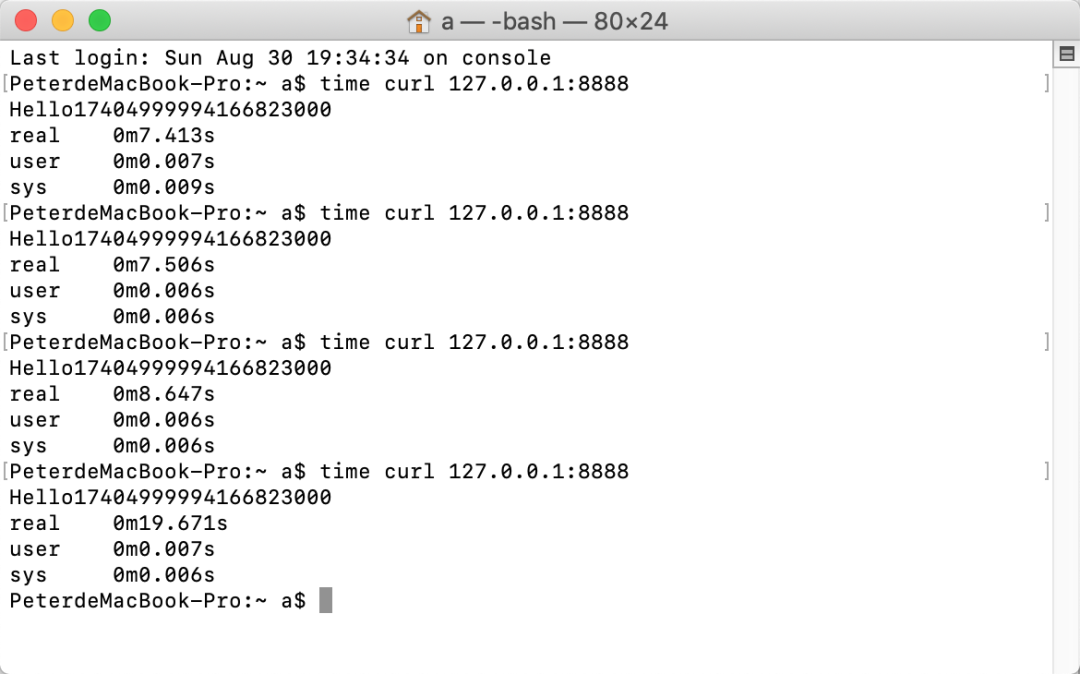
-
为什么这个耗时突然变高,由于我是调用的是本机服务,我看 CPU使用当时很高,差不多打到100%了.但是我后面发现不是这个问题.
问题排查
-
排除掉 CPU问题,看内存消耗占用。
var http = require('http');
http
.createServer(function(request, response) {
console.log(request.url, 'url');
let used = process.memoryUsage().heapUsed / 1024 / 1024;
console.log(
`The script uses approximately ${Math.round(used * 100) / 100} MB`,
'start',
);
console.time('测试');
let num = 0;
for (let i = 1; i < 5900000000; i++) {
num += i;
}
console.timeEnd('测试');
used = process.memoryUsage().heapUsed / 1024 / 1024;
console.log(
`The script uses approximately ${Math.round(used * 100) / 100} MB`,
'end',
);
response.end('Hello' + num);


})
.listen(8888);
-
测试结果: -
内存占用和 CPU都正常 -
跟字符串拼接有关,此刻关闭字符串拼接(此时为了快速测试,我把循环次数降到 5.9亿次)
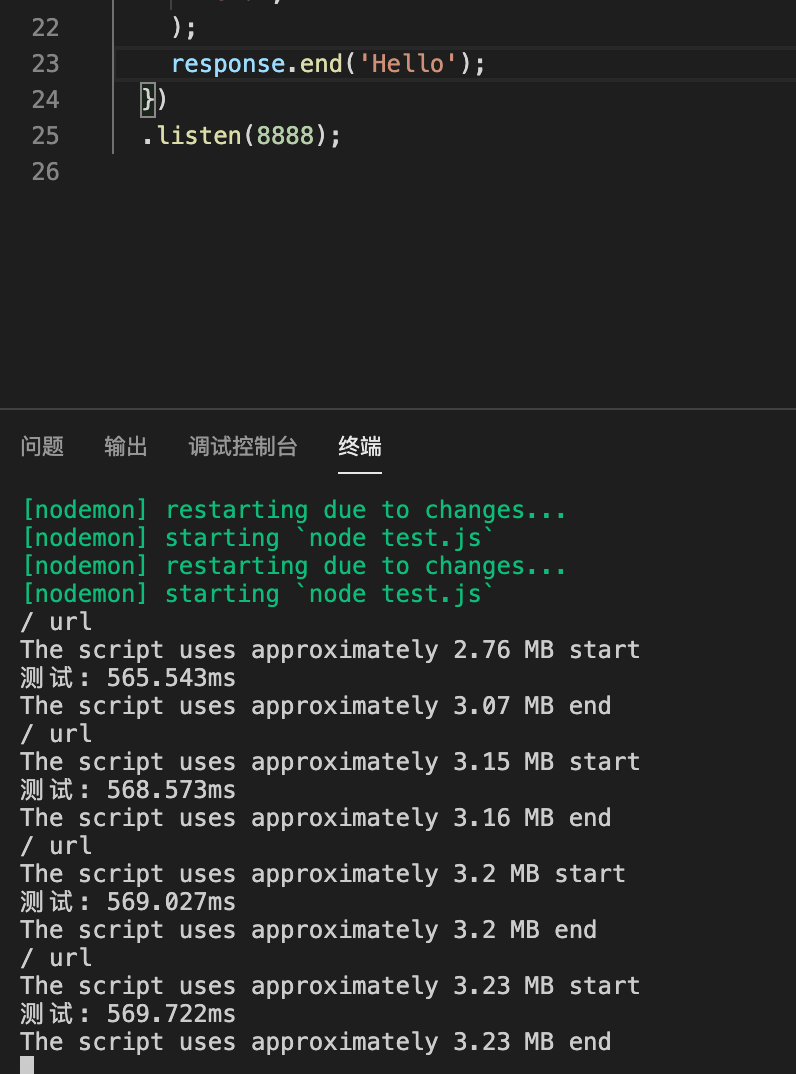
-
发现耗时稳定下来了
定位问题在字符串拼接,先看看字符串拼接的几种方式
-
一、使用连接符 “+” 把要连接的字符串连起来
var a = 'java'
var b = a + 'script'
* 只连接100个以下的字符串建议用这种方法最方便
-
二、使用数组的 join 方法连接字符串
var arr = ['hello','java','script']
var str = arr.join("")
-
比第一种消耗更少的资源,速度也更快
-
三、使用模板字符串,以反引号( ` )标识
var a = 'java'
var b = `hello ${a}script`
-
四、使用 JavaScript concat() 方法连接字符串
var a = 'java'
var b = 'script'
var str = a.concat(b)
五、使用对象属性来连接字符串
function StringConnect(){
this.arr = new Array()
}
StringConnect.prototype.append = function(str) {
this.arr.push(str)
}
StringConnect.prototype.toString = function() {
return this.arr.join("")
}
var mystr = new StringConnect()
mystr.append("abc")
mystr.append("def")
mystr.append("g")
var str = mystr.toString()
更换字符串的拼接方式
-
我把字符串拼接换成了数组的 join方式(此时循环5.9亿次)
var http = require('http');
http
.createServer(function(request, response) {
console.log(request.url, 'url');
let used = process.memoryUsage().heapUsed / 1024 / 1024;
console.log(
`The script uses approximately ${Math.round(used * 100) / 100} MB`,
'start',
);
console.time('测试');
let num = 0;
for (let i = 1; i < 590000000; i++) {
num += i;
}
const arr = ['Hello'];
arr.push(num);
console.timeEnd('测试');
used = process.memoryUsage().heapUsed / 1024 / 1024;
console.log(
`The script uses approximately ${Math.round(used * 100) / 100} MB`,
'end',
);
response.end(arr.join(''));
})
.listen(8888);
-
测试结果,发现接口调用的耗时稳定了( 注意此时是5.9亿次循环)
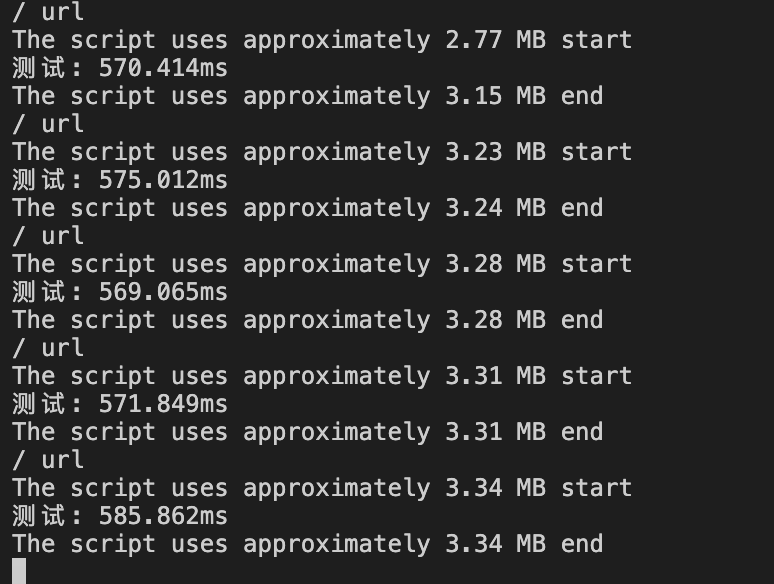
-
《javascript高级程序设计》中,有一段关于字符串特点的描述,原文大概如下:ECMAScript中的字符串是不可变的,也就是说,字符串一旦创建,他们的值就不能改变。要改变某个变量的保存的的字符串,首先要销毁原来的字符串,然后再用另外一个包含新值的字符串填充该变量
就完了?
-
用 +直接拼接字符串自然会对性能产生一些影响,因为字符串是不可变的,在操作的时候会产生临时字符串副本,+操作符需要消耗时间,重新赋值分配内存需要消耗时间。 -
但是,我更换了代码后,发现,即使没有字符串拼接,也会耗时不稳定
var http = require('http');
http
.createServer(function(request, response) {
console.log(request.url, 'url');
let used = process.memoryUsage().heapUsed / 1024 / 1024;
console.log(
`The script uses approximately ${Math.round(used * 100) / 100} MB`,
'start',
);
console.time('测试');
let num = 0;
for (let i = 1; i < 5900000000; i++) {
// num++;
}
const arr = ['Hello'];
// arr[1] = num;
console.timeEnd('测试');
used = process.memoryUsage().heapUsed / 1024 / 1024;
console.log(
`The script uses approximately ${Math.round(used * 100) / 100} MB`,
'end',
);
response.end('hello');
})
.listen(8888);
-
测试结果: -
现在我怀疑,不仅仅是字符串拼接的效率问题,更重要的是 for循环的耗时不一致
var http = require('http');
http
.createServer(function(request, response) {
console.log(request.url, 'url');
let used = process.memoryUsage().heapUsed / 1024 / 1024;
console.log(
`The script uses approximately ${Math.round(used * 100) / 100} MB`,
'start',
);
let num = 0;
console.time('测试');
for (let i = 1; i < 5900000000; i++) {
// num++;
}
console.timeEnd('测试');
const arr = ['Hello'];
// arr[1] = num;
used = process.memoryUsage().heapUsed / 1024 / 1024;
console.log(
`The script uses approximately ${Math.round(used * 100) / 100} MB`,
'end',
);
response.end('hello');
})
.listen(8888);
-
测试运行结果: -
for循环内部的i++其实就是变量不断的重新赋值覆盖 -
经过我的测试发现, 40亿次跟50亿次的区别,差距很大,40亿次的for循环,都是稳定的,但是50亿次就不稳定了. -
Node.js的EventLoop:

-
我们目前被阻塞的状态:
-
我电脑的
CPU使用情况
优化方案
-
遇到了 60亿次的循环,像有使用多进程异步计算的,但是本质上没有解决这部分循环代码的调用耗时。 -
改变策略,拆解单次次数过大的 for循环:
var http = require('http');
http
.createServer(function(request, response) {
console.log(request.url, 'url');
let used = process.memoryUsage().heapUsed / 1024 / 1024;
console.log(
`The script uses approximately ${Math.round(used * 100) / 100} MB`,
'start',
);
let num = 0;
console.time('测试');
for (let i = 1; i < 600000; i++) {
num++;
for (let j = 0; j < 10000; j++) {
num++;
}
}
console.timeEnd('测试');
const arr = ['Hello'];
console.log(num, 'num');
arr[1] = num;
used = process.memoryUsage().heapUsed / 1024 / 1024;
console.log(
`The script uses approximately ${Math.round(used * 100) / 100} MB`,
'end',
);
response.end(arr.join(''));
})
.listen(8888);
-
结果,耗时基本稳定, 60亿次循环总共:
推翻字符串的拼接耗时说法
-
修改代码回最原始的 +方式拼接字符串
var http = require('http');
http
.createServer(function(request, response) {
console.log(request.url, 'url');
let used = process.memoryUsage().heapUsed / 1024 / 1024;
console.log(
`The script uses approximately ${Math.round(used * 100) / 100} MB`,
'start',
);
let num = 0;
console.time('测试');
for (let i = 1; i < 600000; i++) {
num++;
for (let j = 0; j < 10000; j++) {
num++;
}
}
console.timeEnd('测试');
// const arr = ['Hello'];
console.log(num, 'num');
// arr[1] = num;
used = process.memoryUsage().heapUsed / 1024 / 1024;
console.log(
`The script uses approximately ${Math.round(used * 100) / 100} MB`,
'end',
);
response.end(`Hello` + num);
})
.listen(8888);
-
测试结果稳定,符合预期:
总结:
-
对于单次循环超过一定阀值次数的,用拆解方式, Node.js的运行耗时是稳定,但是如果是循环次数过多,那么就会出现刚才那种情况,阻塞严重,耗时不一样。 -
为什么?
深度分析问题
-
遍历60亿次,这个数字是有一些大了,如果是40亿次,是稳定的 -
这里应该还是跟 CPU有一些关系,因为top查看一直是在 升高 -
此处虽然不是真正意义上的内存泄漏,但是我们如果在一个循环中不仅要不断更新 i的值到60亿,还要不断更新num的值60亿,内存使用会不断上升,最终出现两份60亿的数据,然后再回收。(因为GC自动垃圾回收,一样会阻塞主线程,多次接口调用后,CPU占用也会升高) -
使用 for循环拆解后:
for (let i = 1; i < 60000; i++) {
num++;
for (let j = 0; j < 100000; j++) {
num++;
}
}
-
只要 num到60亿即可,解决了这个问题。
哪些场景会遇到这个类似的超大计算量问题:
-
图片处理 -
加解密
❝如果是异步的业务场景,也可以用多进程参与解决超大计算量问题,今天这里就不重复介绍了
❞
最后
-
如果感觉写得不错,可以点个 在看/赞,转发一下,让更多人看到 -
我是 Peter谭老师,欢迎你关注公众号:前端巅峰,后台回复:加群即可加入大前端交流群
本文分享自微信公众号 - 前端巅峰(Java-Script-)。
如有侵权,请联系 support@oschina.cn 删除。
本文参与“OSC源创计划”,欢迎正在阅读的你也加入,一起分享。

